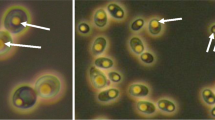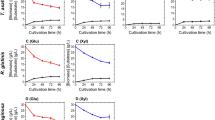Abstract
Conversion of lignocellulosic hydrolysates to lipids using oleaginous (high lipid) yeasts requires alignment of the hydrolysate composition with the characteristics of the yeast strain, including ability to utilize certain nutrients, ability to grow independently of costly nutrients such as vitamins, and ability to tolerate inhibitors. Some combination of these characteristics may be present in wild strains. In this study, 48 oleaginous yeast strains belonging to 45 species were tested for ability to utilize carbon sources associated with lignocellulosic hydrolysates, tolerate inhibitors, and grow in medium without supplemented vitamins. Some well-studied oleaginous yeast species, as well as some that have not been frequently utilized in research or industrial production, emerged as promising candidates for industrial use due to ability to utilize many carbon sources, including Cryptococcus aureus, Cryptococcus laurentii, Hannaella aff. zeae, Tremella encephala, and Trichosporon coremiiforme. Other species excelled in inhibitor tolerance, including Candida aff. tropicalis, Cyberlindnera jadinii, Metschnikowia pulcherrima, Schwanniomyces occidentalis and Wickerhamomyces ciferrii. No yeast tested could utilize all carbon sources and tolerate all inhibitors tested. These results indicate that yeast strains should be selected based on characteristics compatible with the composition of the targeted hydrolysate. Other factors to consider include the production of valuable co-products such as carotenoids, availability of genetic tools, biosafety level, and flocculation of the yeast strain. The data generated in this study will aid in aligning yeasts with compatible hydrolysates for conversion of carbohydrates to lipids to be used for biofuels and other oleochemicals.


Similar content being viewed by others
References
Li Q, Du W, Dehua L (2008) Perspectives of microbial oils for biodiesel production. Appl Microbiol Biotechnol 80:749–756
Rossi M, Amaretti A, Raimondi S, Leonardi A (2011) Getting lipids for biodiesel production from oleaginous fungi. biodiesel—feedstocks and processing technologies. InTech, Rijeka, pp 71–92
Shi S, Valle-Rodriguez J, Siewers V, Nielsen J (2011) Prospects for microbial biodiesel production. Biotechol J 6:277–285
Sitepu IR, Sestric R, Ignatia L, Levin D, Bruce German J, Gillies LA, Almada LA, Boundy-Mills KL (2013) Manipulation of culture conditions alters lipid content and fatty acid profiles of a wide variety of known and new oleaginous yeasts species. Bioresour Technol 144:360–369
Franklin S, Decker SM, Wee J (2011) Fuel and chemical production from oleaginous yeast. Google Patents
Rattray J (1988) Yeast. In: Ratledge C, Wilkinson S (eds) Microbial lipids, vol 1. Academic Press, London, pp 555–697
Rattray J, Scheibeci A, Kidby D (1975) Lipids of yeasts. Bacteriol Rev 39(3):197–231
Trimbur DE, Im C-S, Dillon HF, Day AG, Franklin S, Coragliotti A (2012) Renewable chemicals and fuels from oleaginous yeast. Google Patents
Huang C, Chen X-F, Xiong L, Chen X-D, Ma L–L, Chen Y (2013) Single cell oil production from low-cost substrates: the possibility and potential of its industrialization. Biotechnol Adv 31:129–139
Huang C, Chen X-F, Xiong L, Yang X-Y, Chen X-D, Ma L-L, Chen Y (2013) Microbial oil production from corncob acid hydrolysate by oleaginous yeast Trichosporon coremiiforme. Biomass Bioenergy 49:273–278
Huang C, Zong M-H, Wu H, Liu Q-P (2009) Microbial oil production from rice straw hydrolysate by Trichosporon fermentans. Bioresour Technol 100(19):4535–4538
Li M, Liu G-L, Chi Z, Chi Z-M (2010) Single cell oil production from hydrolysate of cassava starch by marine-derived yeast Rhodotorula mucilaginosa TJY15a. Biomass Bioenergy 34(1):101–107
Liu W, Wang Y, Yu Z, Bao J (2012) Simultaneous saccharification and microbial lipid fermentation of corn stover by oleaginous yeast Trichosporon cutaneum. Bioresour Technol 118:13–18
Tsigie YA, Wang C-Y, Truong C-T, Ju Y-H (2011) Lipid production from Yarrowia lipolytica Po1g grown in sugarcane bagasse hydrolysate. Bioresour Technol 102(19):9216–9222
Wang Q, Guo F-J, Rong Y-J, Chi Z-M (2012) Lipid production from hydrolysate of cassava starch by Rhodosporidium toruloides 21167 for biodiesel making. Renew Energy
Yu X, Zheng Y, Dorgan K, Chen S (2011) Oil production by oleaginous yeasts using the hydrolysate from pretreatment of wheat straw with dilute sulfuric acid. Bioresour Technol 102:6134–6140
Chen X, Li Z, Zhang X, Hu F, Ryu D, Bao J (2009) Screening of oleaginous yeast strains tolerant to lignocellulose degradation compounds. Appl Biochem Biotechnol 159:591–604
Palmqvist E, Hahn-Hagerdal B (2000) Fermentation of lignocellulosic hydrolysates. I: inhibition and detoxification. Bioresour Technol 74:17–24
Palmqvist E, Hahn-Hägerdal B (2000) Fermentation of lignocellulosic hydrolysates. II: inhibitors and mechanisms of inhibition. Bioresour Technol 74(1):25–33
Zha Y, Muilwijk B, Coulier L, Punt P (2012) Inhibitory compounds in lignocellulosic biomass hydrolysates during hydrolysate fermentation processes. J Bioprocess Biotech 2(1):112–122. doi:10.4172/2155-9821.1000112
Kurtzman C, Fell J, Boekhout T, Robert V (2011) Methods for isolation, phenotypic characterization and maintenance of yeasts, chap 7, vol 1. The yeasts: a taxonomic study. Elsevier, Amsterdam
Suutari M, Priha P, Laakso S (1993) Temperature shifts in regulation of lipids accumulated by Lipomyces starkeyi. J Am Oil Chem Soc 70:891–894
Suutari M, Priha P, Laakso S (1993) Temperature shifts in regulation of lipids accumulated by Lipomyces starkeyi. J Am Oil Chem Soc 70(9):891–894. doi:10.1007/BF02545349
Kurtzman CP (2011) Yarrowia van der Walt & von Arx (1980). In: Kurtzman CP, Fell J, Boekhout T (eds) The yeasts: a taxonomic study, vol 2, 5th edn. Elsevier, Amsterdam, pp 927–929
Kurtzman C, Fell J, Boekhout T (2011) The yeasts: a taxonomic study, 5th edn. Elsevier, Amsterdam
Boundy-Mills K (2008) The Phaff Yeast Culture Collection has found its niche. Soc Ind Microbiol News 58(2):49–56
Boundy-Mills K (2012) Yeast culture collections of the world: meeting the needs of industrial researchers. J Ind Microbiol Biotechnol 39(5):673–680
McCluskey K, Wiest A, Boundy-Mills K (2014) Genome data drives change at culture collections, chap 4. In: Nowrousian M (ed) Fungal genomics, 2nd edn. Springer, Heidelberg
Hu C, Zhao X, Zhao J, Wu S, Zongbao K (2009) Effects of biomass hydrolysis by-products on oleaginous yeast Rhodosporidium toruloides. Bioresour Technol 100(20):4843–4847
Huang C, Wu H, Liu Q-p, Li Y-y, Zong M-h (2011) Effects of aldehydes on the growth and lipid accumulation of oleaginous yeast Trichosporon fermentans. J Agric Food Chem 59(9):4606–4613
Huang C, Wu H, Liu Z, Cai J, Lou W, Zong M (2012) Effect of organic acids on the growth and lipid accumulation of oleaginous yeast Trichosporon fermentans. Biotechnol Biofuels 5:4
Yu X, Zeng J, Zheng Y, Chen S (2013) Effect of lignocellulose degradation products on microbial biomass and lipid production by the oleaginous yeast Cryptococcus curvatus. Process Biochem
Qin L, Liu Z-H, Li B-Z, Dale BE, Yuan Y-J (2012) Mass balance and transformation of corn stover by pretreatment with different dilute organic acids. Bioresour Technol 112:319–326
Zhang J, Zhu Z, Wang X, Wang N, Wang W, Bao J (2010) Biodetoxification of toxins generated from lignocellulose pretreatment using a newly isolated fungus, Amorphotheca resinae ZN1, and the consequent ethanol fermentation. Biotechnol Biofuels 3(26):1–15
Rumbold K, van Buijsen HJ, Overkamp KM, van Groenestijn JW, Punt PJ, van der Werf MJ (2009) Microbial production host selection for converting second-generation feedstocks into bioproducts. Microb Cell Fact 8:64
Sitepu I, Ignatia L, Franz A, Wong D, Faulina S, Tsui M, Kanti A, Boundy-Mills K (2012) An improved high-throughput Nile red fluorescence assay for estimating intracellular lipids in a variety of yeast species. J Microbiol Methods 91(2):321–328
Smith MT, Kurtzman CP (2011) Lipomyces Lodder & Kreger-van Rij (1952). In: Kurtzman CP, Fell J, Boekhout T (eds) The yeasts: a taxonomic study, vol 2, 5th edn. Elsevier, Amsterdam, pp 545–560
Andreevskaya V, Zalashko M (1979) Effect of addition of salts on growth and synthesis of lipid in yeasts cultured on peat oxidates. Prikladnaya Biokhimiya i Mikrobiologiya 15:522–527
Malkhas’ian S, Nechaev A, Gavrilova N, Zotova E, Doronina O (1982) Group and fatty acid composition of the lipids in yeasts of the genus Candida. Prikl Biokhim Mikrobiol 18(5):621–629
Eroshin V, Krylova N (1983) Efficiency of lipid synthesis by yeasts. Biotechnol Bioeng 25:1693–1700
Enebo L, Elander M, Berg F, Lundin H, Nilsson R, Myrbäck K (1944) Mikrobielle Fettsynthese durch Lufthefezuchtung von Rhodotorulaarten. I V A 6:1
Moon N, Hammond E, Glatz B (1978) Conversion of cheese whey and whey permeate to oil and single-cell protein. J Dairy Sci 61:1537–1547
Boulton C, Ratledge C (1981) Correlation of lipid accumulation in yeasts with possession of ATP:citrate lyase. Microbiology 127(1):169–176
Jigami Y, Suzuki O, Nakasato S (1979) Comparison of lipid composition of Candida guilliermondii grown on glucose, ethanol and methanol as the sole carbon source. Lipids 14(11):937–942
Kitcha S, Cheirsilp B (2011) Screening of oleaginous yeasts and optimization for lipid production using crude glycerol as a carbon source. Energy Proc 9:274–282
Stanier R (1946) Some aspects of microbiological research in Germany. B.I.O.S. Final Report No. 691, Item No. 24. British Intelligence Objectives Sub-Committee, London
Pan L-X, Yang D-F, Shao L, Li W, Chen G-G, Liang Z-Q (2009) Isolation of the oleaginous yeasts from the soil and studies of their lipid-producing capacities. Food Technol Biotechnol 47(2):215–220
Gill C, Hall J, Ratledge C (1977) Lipid accumulation in an oleaginous yeast (Candida 107) growing on glucose in single-stage continuous culture. Appl Environ Microbiol 33(2):231–239
Guerzoni M, Lambertini P, Lercker G, Marchetti R (1985) Technological potential of some starch degrading yeasts. Starch 37(2):52–57
Matsuo T, Terashima M, Hasimoto Y, Hasida W (1981) Method for producing cacao butter substitute. USA Patent 4(308):350
Sentheshanmuganathan S, Nickerson W (1962) Composition of cells and cell walls of triangular and ellipsoidal forms of Trigonopsis variabilis. J Gen Microbiol 27:451–464
Hopton J, Woodbine M (1960) Fat synthesis by yeasts. I. A comparative assessment of Hansenula species. J Appl Bacteriol 23(2):283–290
Bati N, Hammond E, Glatz B (1984) Biomodification of fats and oils: trials with Candida lipolytica. J Am Oil Chem Soc 61(11):1743–1746
Acknowledgments
Some yeasts used in this study were isolated and identified as part of a collaborative project with the Government of the Republic of Indonesia, funded by Grant Number U01TW008160 from the NIH Fogarty International Center, the NIH Office of Dietary Supplements, the National Science Foundation and the Department of Energy. This project was supported by the USDA Agricultural Food Research Initiative of the National Food and Agriculture, USDA, Grant #35621-04750. The content is solely the responsibility of the authors and does not necessarily represent the official views of the Fogarty International Center or the National Institutes of Health, the Office of Dietary Supplements, the National Science Foundation, the Department of Energy, or the Department of Agriculture. We appreciate the contribution of Elizabeth Widjaja, LIPI Center for Biology, Cibinong, Indonesia for identifying plant hosts of yeasts M076LWD and PLE1112RB. We appreciate the contribution of Nathan Schiff for identification of the insect host of yeast T2002RA. Eveline Tioniwar provided technical assistance. The anonymous reviewers provided valuable feedback that significantly improved the quality of the manuscript.
Author information
Authors and Affiliations
Corresponding author
Rights and permissions
About this article
Cite this article
Sitepu, I., Selby, T., Lin, T. et al. Carbon source utilization and inhibitor tolerance of 45 oleaginous yeast species. J Ind Microbiol Biotechnol 41, 1061–1070 (2014). https://doi.org/10.1007/s10295-014-1447-y
Received:
Accepted:
Published:
Issue Date:
DOI: https://doi.org/10.1007/s10295-014-1447-y




